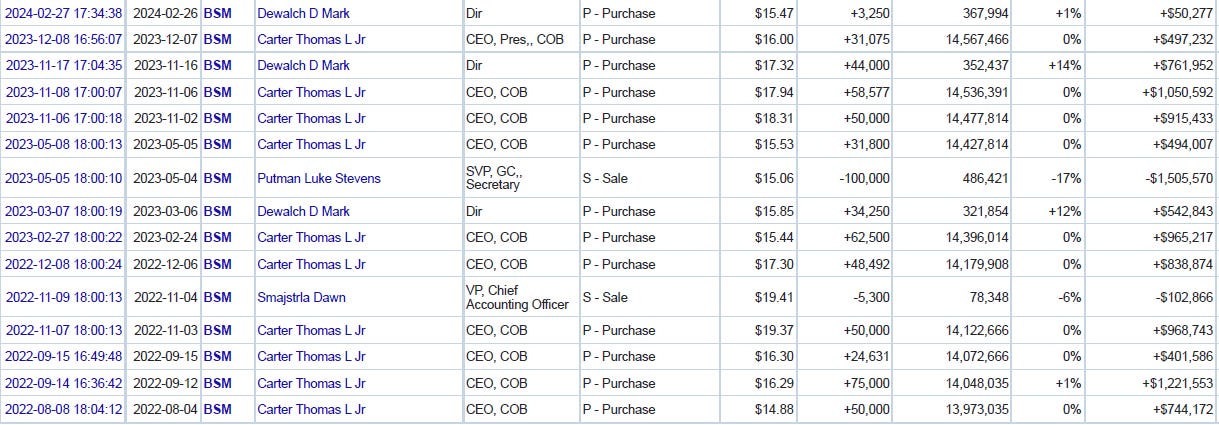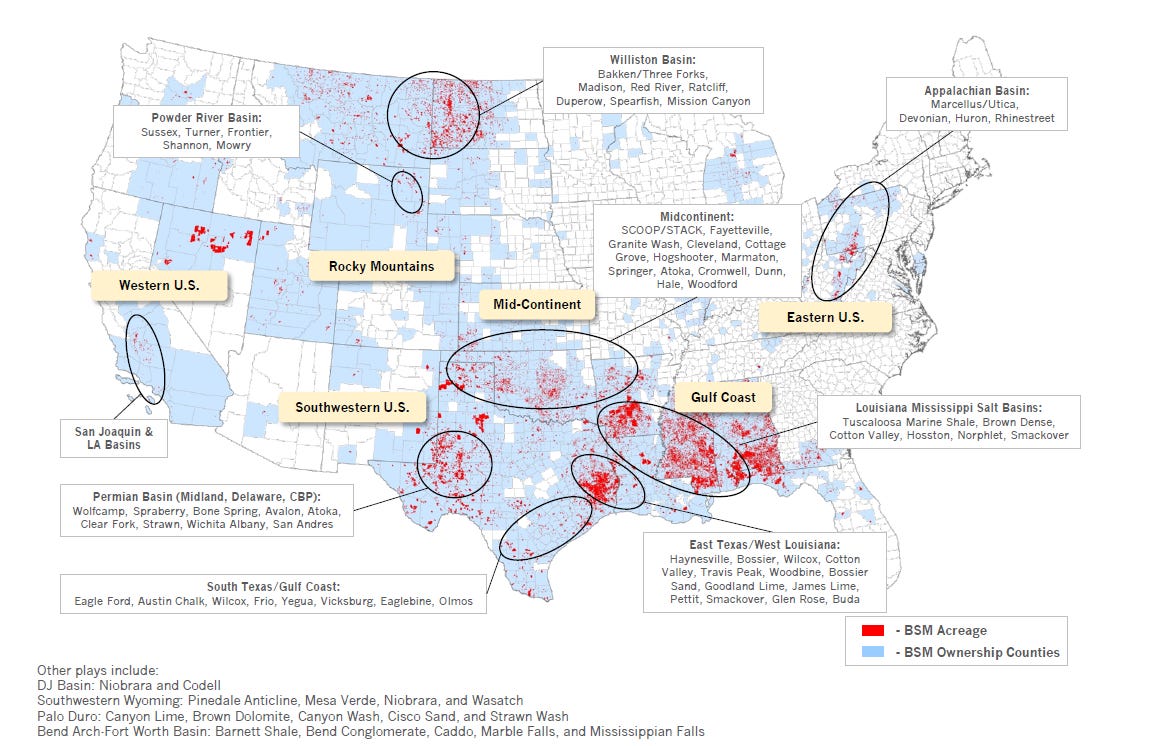Welcome to the “Probably Not a Value Trap” series where I discuss businesses with a 10%+ dividend yield which I believe probably won’t get cut and why, but don’t come after me on Twitter if they do.
Black Stone Minerals (BSM) is an oil and gas royalty limited partnership with 7.4 million net royalty acres. They have concentrated positions in the Permian, Haynesville, and Bakken shale basins. These concentrated positions are important as it gives them some amount of influence to exert on the contracting process with their drillers, and they actively market their acreage.
We all know that natural gas prices have been weak for these last couple of years, but oil prices have held relatively steady. The Haynesville basin in particular is 95% natural gas, and so this leg of the BSM stool has been a bit wobbly. But, BSM uses derivative hedges to stabilize their cashflows, currently 60% of their 2024 natural gas production is hedged at a price of $3.55 per mmbtu, which has dramatically outperformed the Q1 average Henry Hub price of $2.24. Since prices had been high in 2022 when the derivative hedges were acquired, during 2023 BSM was able to hold the line on their income where unhedged competitors fell off a cliff. But derivative hedges are usually only purchased on about a one year basis.
The primary reason I believe that the dividend won’t be cut from here, is that it was just cut, from $1.90 a year to $1.50 a year, and this leaves BSM with a dividend coverage of 1.22x. The depth of the cut, and the excess coverage from here gives BSM wiggle room if prices were to keep declining, but also to finance their acquisition strategy. BSM’s modus operandi is to use debt to make large royalty acreage acquisitions, and then pay down that debt over the subsequent few years. BSM’s acquisition cannon is loaded from paying down their previous acquisition’s debt, and now they are off on a shopping spree. Management spent $50 million last quarter, and says they have multiples of that left to spend on this jaunt. They are not focusing on the Permian due to the current buying frenzy and high prices, and hinted that they were looking for contiguous acreage to increase their strategic power. I believe that they will be contrarian and buy more Haynesville acreage due to the low natural gas prices, which have the potential to rise as LNG export terminals are coming online in 2025 and 2026.
What makes Black Stone Minerals unique is that their size gives them enough power to dictate terms to operators. Drillers on BSM land have to commit to, for example, maintaining five active drill rigs at all times no matter what the price of natural gas does. During this current period of soft natural gas prices, this gives BSM a much greater resiliency of income than other royalty companies. The contracts are only moderately as draconian as I am letting on, just this last quarter one of their operators invoked a provision in their contract that allowed them to take a “time out” from operating due to the depressed prices. But on average, this strategic power does help BSM have a continuity of income beyond their peers, which bolsters confidence that the dividend is stable. Mineral Royalty peers either try to spread purchases out across the bingo card in the hopes that there will be drilling somewhere, or alternatively, PHX Minerals (PHX) uses a team of geologists to try and predict where drilling will be next, and buy rights based on that prediction. BSM buys a large swathe of land, and knuckles operators to come to the table and agree to their terms.
Another important aspect to this active marketing of their acreage and strategic power is that the contracts signed have escalations. In the Shelby Trough, Aethon is on the hook to increase from 4 wells per year to 15 wells per year, and on a separate parcel, from 5 wells per year to 12 wells per year. This should provide a built in productivity increase. Because of this unique market position, BSM, at a scant $3.2 billion market capitalization, averages between 6% and 10% of all new horizontal permitting activity, and for the last three years, has maintained between 60 and 100 active drilling rigs on their acreage. To put things in perspective, there are somewhere between 350 million acres and 650 million acres in the major shale basins in the United States. BSM with 20 million acres, 7.4 million net royalty acres, represents less than a half of a percent of total acreage, and maintains at least 6% of all drilling activity on their land. At the end of Q4 2023, there were 620 drilling rigs active in the US, and 63 of them were on BSM land. Sign me up.
The founder, CEO, president, and chairman of the board, Thomas Carter is still actively buying stock in BSM frequently, in sizable amounts, and has bought at prices higher than the current stock price. I love it when there’s a bold and skilled helmsman unapologetically piloting the ship.
At a current market price of $15.60 a share, and a current dividend of $0.375 a quarter, or $1.50 a year, it will require an options strategy to meet the 10% dividend yield threshold. For example, if you had an ultimate position size target in your portfolio for 200 shares, you could buy 100 shares, and sell one put at a strike price of $15 and a maturity of January 17, 2025 for $83. If the price of BSM stays above $15, you will have an acquisition cost of your 100 shares of $14.77 a share and a dividend yield of 10.15%. If the stock price falls below $15 a share and you get filled, you will have 200 shares at an average price of $15.18, but selling one six month call at a strike price of $15 should return somewhere near enough to bring your cost of acquisition below $15 a share and result in a dividend yield above 10%. Feel free to criticize me for playing a little fast and loose with my own rules, it’s not a true 10% dividend yield without the finagling.
I would not anticipate an increase in the dividend payout until some progress has been made paying down the debt from their current acquisition spree, unless of course natural gas prices were to rise. There is currently about 14 billion cubic feet per day (bcfd) of export terminal capacity, and that is supposed to increase to 18 bcfd by 2025. With natural gas as the stepping-stone electricity generation fuel of choice, these mineral rights should have decades of staying power. I put a small BSM position in my wife’s Roth IRA with dividend reinvestment turned on.








if i am not wrong, BSM is master limited partnerships, so for non us investors, dividend tax is like 40% and when you sell they deduct another 10% based on rule changes some years back?
Mate you literally stole my thunder - had this as my next piece! haha
Great job, really good insights here.